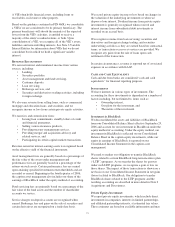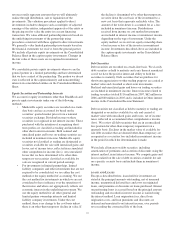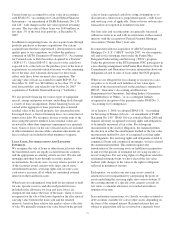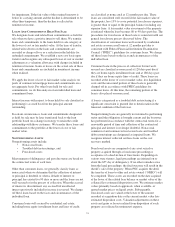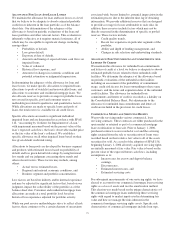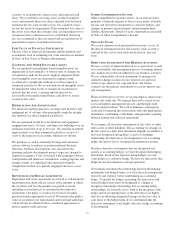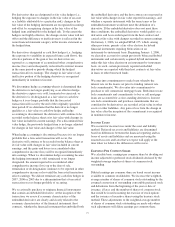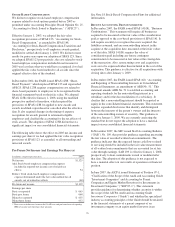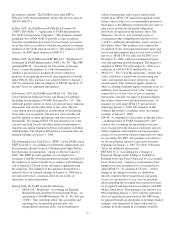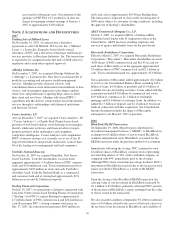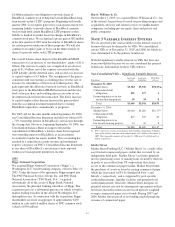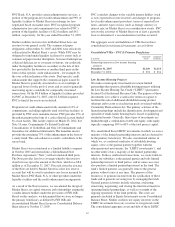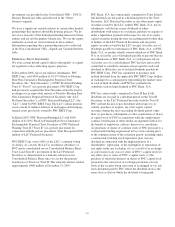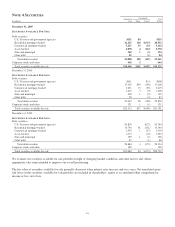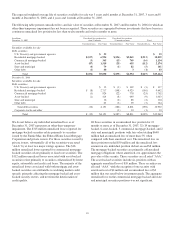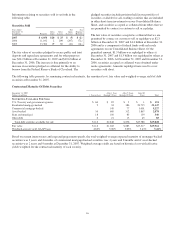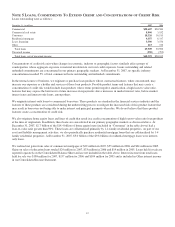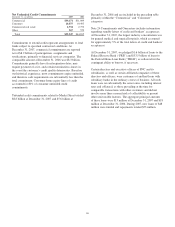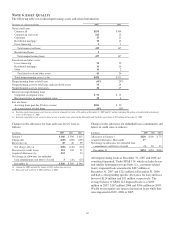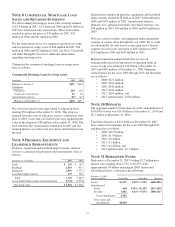PNC Bank 2007 Annual Report Download - page 86
Download and view the complete annual report
Please find page 86 of the 2007 PNC Bank annual report below. You can navigate through the pages in the report by either clicking on the pages listed below, or by using the keyword search tool below to find specific information within the annual report.
$.6 billion related to our obligation to provide shares of
BlackRock common stock to help fund certain BlackRock long-
term incentive plan ("LTIP") programs. Beginning with fourth
quarter 2006, we recognize gain or loss each quarter-end on our
remaining liability to provide shares of BlackRock common
stock to help fund certain BlackRock LTIP programs as that
liability is marked to market based on changes in BlackRock’s
common stock price. We recognized a pretax gain of $82 million
in the first quarter of 2007 from the transfer of BlackRock shares
for certain payouts under one of these programs. We will also
continue to recognize gains or losses on the future transfer of
shares for payouts under such LTIP programs.
The overall balance sheet impact of the BlackRock/MLIM
transaction was an increase to our shareholders’ equity of $1.6
billion. The increase to equity was comprised of an after-tax
gain of $1.3 billion, net of the expense associated with the
LTIP liability and the deferred taxes, and an after-tax increase
to capital surplus of $.3 billion. The recognition of the gain is
consistent with our existing accounting policy for the sale or
issuance by subsidiaries of their stock to third parties. The
gain represents the difference between our basis in BlackRock
stock prior to the BlackRock/MLIM transaction and the new
book value per share and resulting increase in value of our
investment realized from the transaction. The direct increase
to capital surplus rather than inclusion in the gain resulted
from the accounting treatment required due to existing
BlackRock repurchase commitments or programs.
For 2005 and for the nine months ended September 30, 2006,
our Consolidated Income Statement included our former 69%
– 71% ownership interest in BlackRock’s net income through
the closing date. However, beginning September 30, 2006, our
Consolidated Balance Sheet no longer reflected the
consolidation of BlackRock’s balance sheet but recognized
our ownership interest in BlackRock as an investment
accounted for under the equity method. This accounting has
resulted in a reduction in certain revenue and noninterest
expense categories on PNC's Consolidated Income Statement
as our share of BlackRock’s net income is now reported
within asset management noninterest income.
2005
Riggs National Corporation
We acquired Riggs National Corporation (“Riggs”), a
Washington, D.C. based banking company, effective May 13,
2005. Under the terms of the agreement, Riggs merged into
The PNC Financial Services Group, Inc. and PNC Bank,
National Association (“PNC Bank, N.A.”) acquired
substantially all of the assets of Riggs Bank, National
Association, the principal banking subsidiary of Riggs. The
acquisition gave us a substantial presence on which to build a
market leading franchise in the affluent Washington, D.C.
metropolitan area. In connection with the acquisition, Riggs
shareholders received an aggregate of approximately $297
million in cash and 6.6 million shares of PNC common stock
valued at $356 million.
Harris Williams & Co.
On October 11, 2005, we acquired Harris Williams & Co., one
of the nation’s largest firms focused on providing mergers and
acquisitions advisory and related services to middle market
companies, including private equity firms and private and
public companies.
N
OTE
3V
ARIABLE
I
NTEREST
E
NTITIES
We are involved with various entities in the normal course of
business that may be deemed to be VIEs. We consolidated
certain VIEs as of December 31, 2007 and 2006 for which we
were determined to be the primary beneficiary.
We hold significant variable interests in VIEs that have not
been consolidated because we are not considered the primary
beneficiary. Information on these VIEs follows:
Non-Consolidated VIEs – Significant Variable Interests
In millions
Aggregate
Assets
Aggregate
Liabilities
PNC Risk
of Loss
December 31, 2007
Market Street $5,304 $5,330 $9,019(a)
Collateralized debt
obligations 255 177 6
Partnership interests in low
income housing projects 50 34 8
Total $5,609 $5,541 $9,033
December 31, 2006
Market Street $4,020 $4,020 $6,117(a)
Collateralized debt
obligations 815 570 22
Partnership interests in
low income housing projects 33 30 8
Total $4,868 $4,620 $6,147
(a) PNC’s risk of loss consists of off-balance sheet liquidity commitments to Market
Street of $8.8 billion and other credit enhancements of $.2 billion at December 31,
2007. The comparable amounts at December 31, 2006 were $5.6 billion and $.6
billion, respectively.
Market Street
Market Street Funding LLC (“Market Street”) is a multi-seller
asset-backed commercial paper conduit that is owned by an
independent third party. Market Street’s activities primarily
involve purchasing assets or making loans secured by interests
in pools of receivables from US corporations that desire
access to the commercial paper market. Market Street funds
the purchases of assets or loans by issuing commercial paper
which has been rated A1/P1 by Standard & Poor’s and
Moody’s, respectively, and is supported by pool-specific
credit enhancements, liquidity facilities and program-level
credit enhancement. Generally, Market Street mitigates its
potential interest rate risk by entering into agreements with its
borrowers that reflect interest rates based upon its weighted
average commercial paper cost of funds. During 2007 and
2006, Market Street met all of its funding needs through the
issuance of commercial paper.
81


